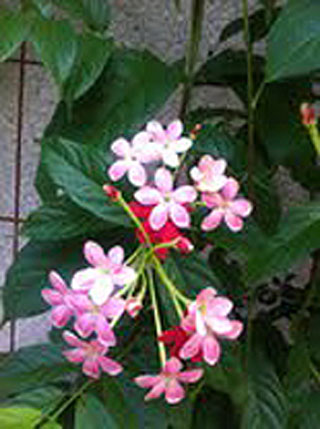Resource Library
Plant of the Week: Rangoon Creeper
Rangoon Creeper
Latin: Quisqualis indica

Rangoon Creeper, a tropical vine, can make a beautiful showing even in temperate gardens. Only version available. (Image courtesy Gerald Klingaman)
With each passing year that sentiment takes on new meaning as I realize I’ll never be able to know all the plants. Just yesterday I walked by a bed and got a whiff of something sweet and fruity; investigating I found a new plant -- Rangoon Creeper, Quisqualis indica.
Rangoon creeper belongs to the tropical Combretaceae family and has recently had a name change to Combretum indicum. It is a fast-growing sprawling vine that, like most vines, can grow about as high and wide as conditions permit. It is a tropical vine from Asia, Indonesia, the Philippines and Africa that has been naturalized throughout the tropical world. The roots are cold hardy in the ground to zone 8 in a sheltered south-facing location but the vine freezes back whenever temperatures drop below freezing. Where freezing temperatures occur vines seldom exceed 10 or 12 feet of growth in a season.
It has simple, opposite ovate leaves that are to 4 inches long and slightly stinky when bruised, a factor that apparently keeps deer and rabbits from feeding on the foliage. On older stems, as the leaves begin to drop, a downward pointed spur develops that serves as a kind of hanger for the vine that keeps it in place as it sprawls about.
Rangoon creeper flowers during hot weather with clusters of flowers with slender, 2-inch long tubes ending in five petals at their apex. The flower clusters are produced on new growth at both the terminus of the shoot and in the leaf axils so plants remain in bloom for much of the summer. he flowers have a sweet fruity fragrance that is most pronounced in the evening when new flowers open but remains present even during the heat of the day.
Three different flower colors – white, pink and red – are often found on the same plant. In late evening flowers open white then fade to pink and finally red during their three-day life cycle.
The white flowers attract large flying moths such as the hawkmoth and sphinx moth which are unable to see the darker colored flowers in the same cluster. During the daylight as the flowers change from pink to red, a different set of pollinators is attracted to the blossom.
Rangoon creeper is likely to be hardy out of doors only in south Arkansas and then only when nestled up close to the foundation of a building on the south side where the soil is warmed by the winter sun. For colder areas it can be grown as a summer annual or kept in a large pot as a patio plant. It should have full sun and a warm position. If the plant gets too unruly in its spread, cutting back hard and often will control growth without significantly reducing the number of blooms.
By: Gerald Klingaman, retired
Retired Extension Horticulturist - Ornamentals
Extension News - October 4, 2013